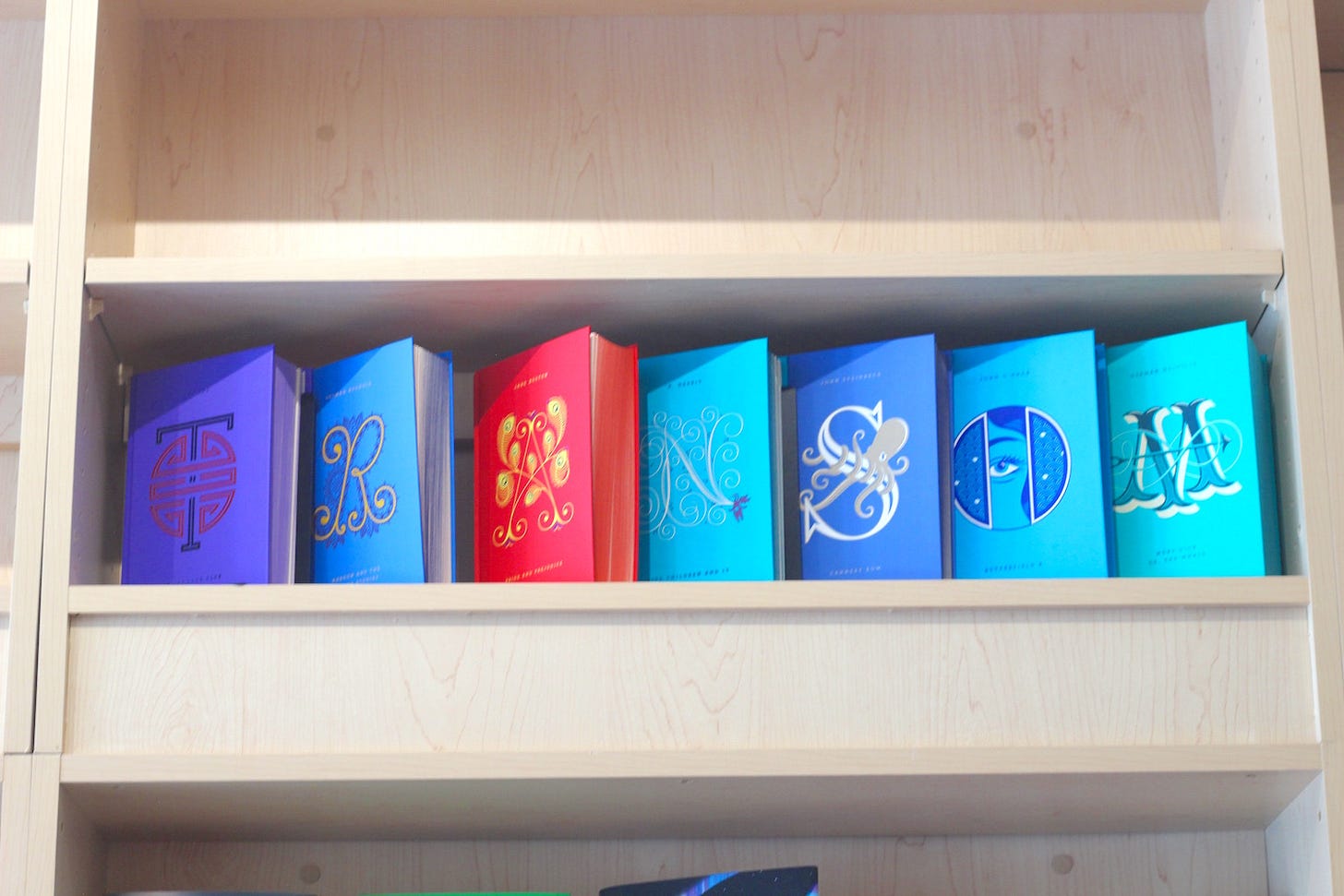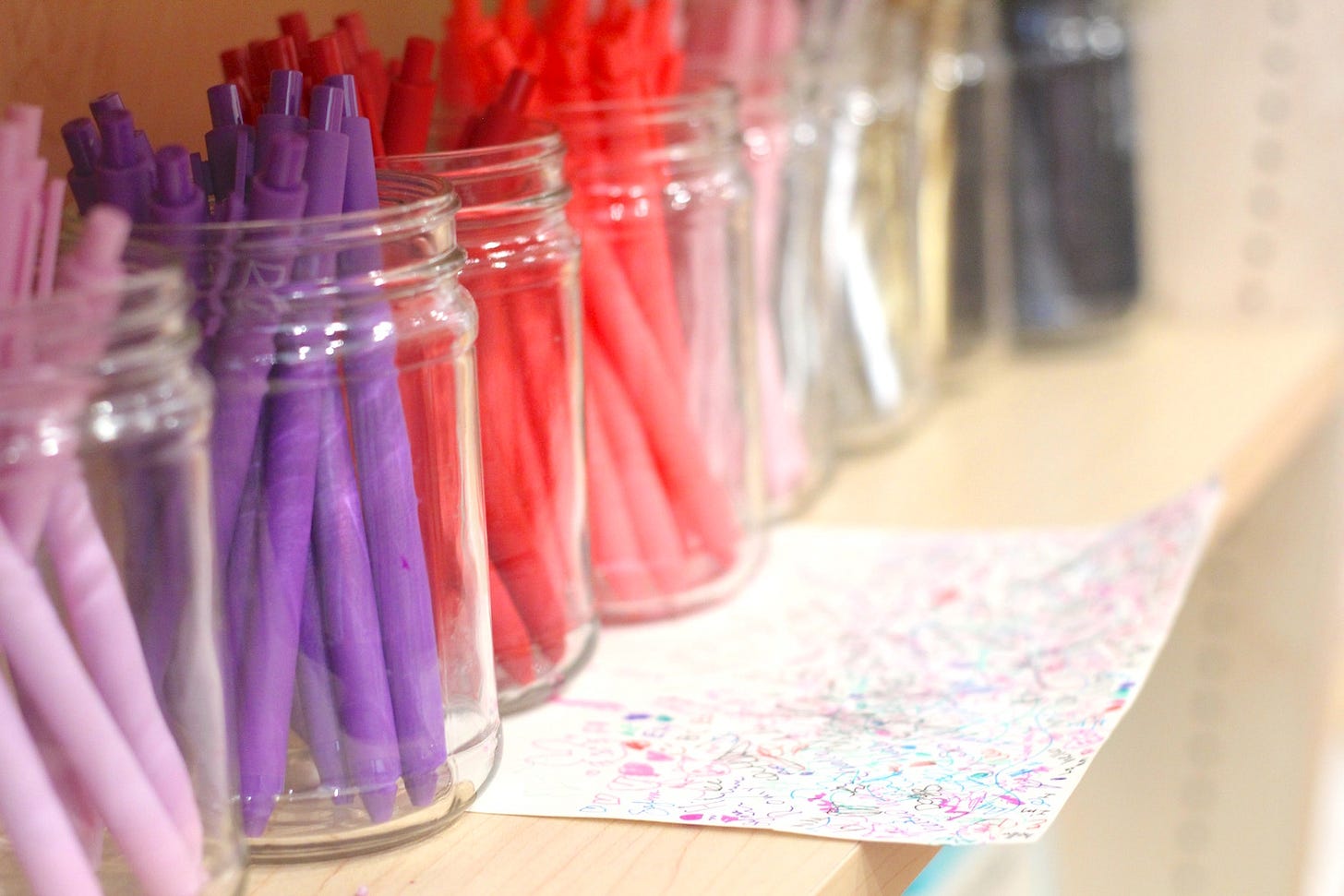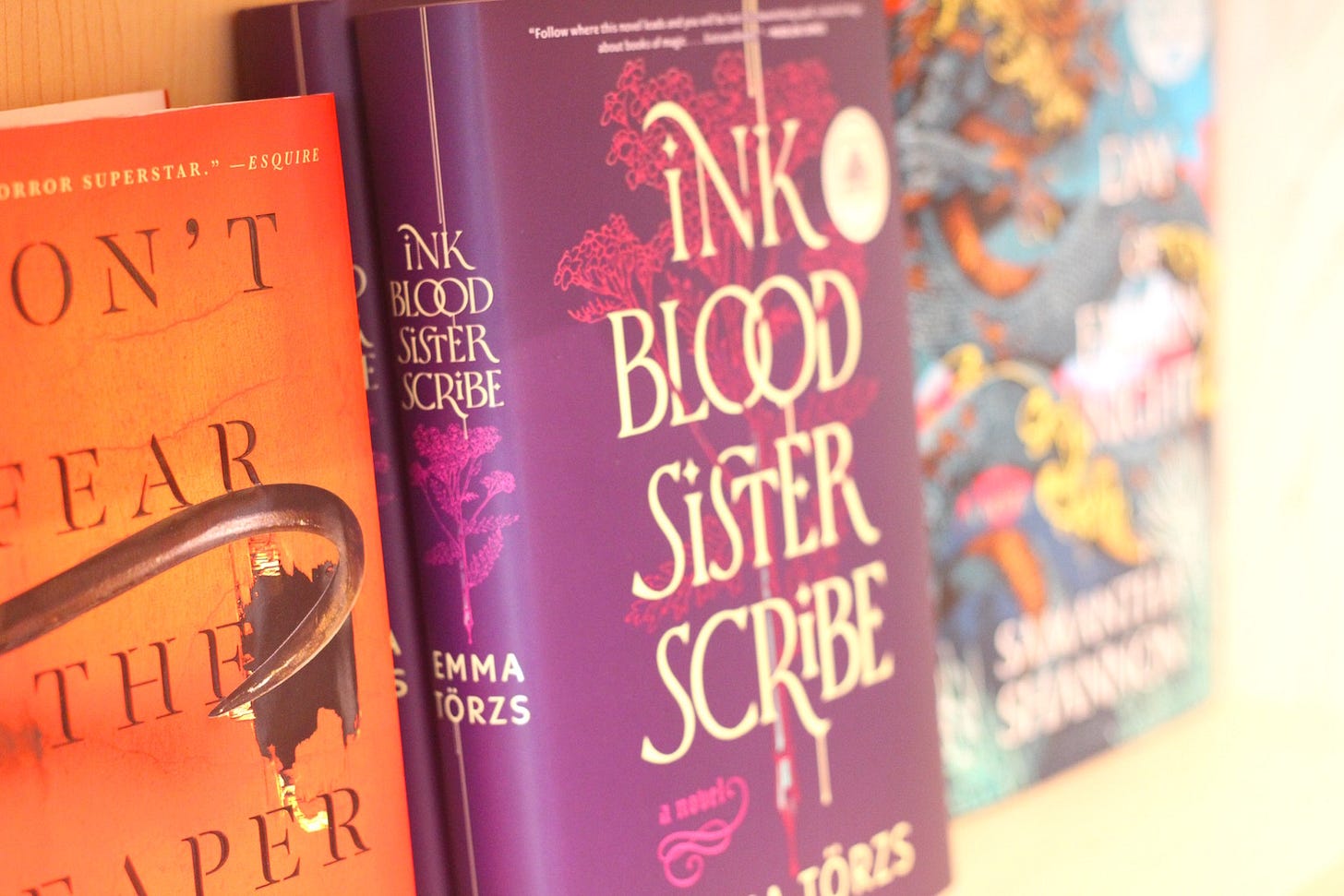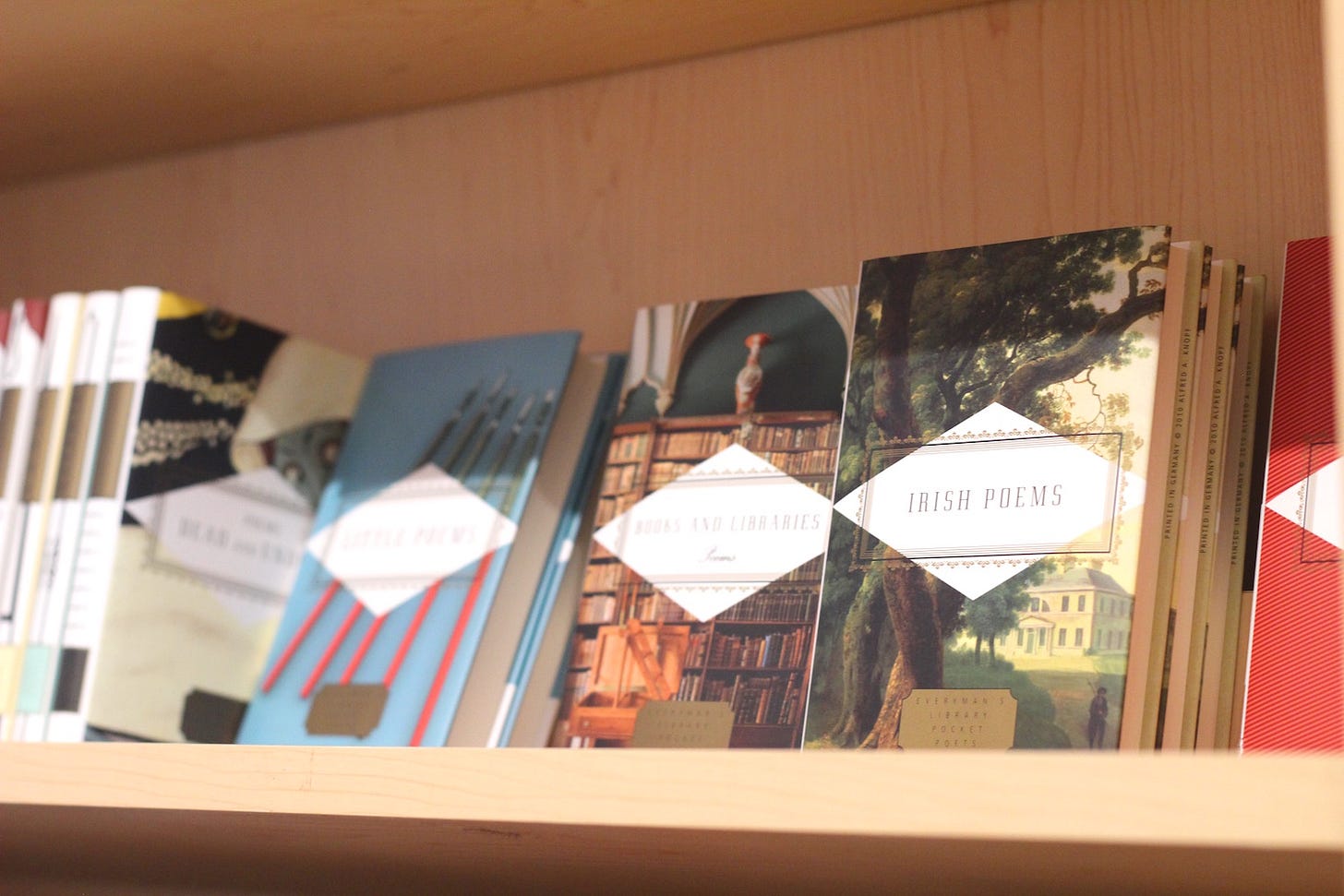Transom owner Chris Steib lives in Tarrytown, just a few blocks from his colorful, whimsical, and bright bookshop.
When you speak to Chris, you feel like he’s giving you his total attention. And his sparkling hazel eyes hold stories you think must rival what sits on the shelves.
After visiting Transom and meeting Chris, we knew we wanted to hear more from him via interview. Now you can, too. Read on.
Owner Chris Steib inside the bookshop. Photo from Transom website
Ossining Magazine (OM): Share a little about your background before you opened Transom Bookshop.
Chris Steib (CS): Like many liberal arts majors, I ran the whole gamut of jobs throughout my career. I started off teaching high school English and tutoring in LA,, held a few managerial roles at Barnes & Noble, edited a (now defunct) literary magazine, and wrote speeches for execs at NBC and GE. I then took a 15-year digital detour, working as a web designer and product manager, and eventually a strategy consultant for tech startups, while mentoring managers and teaching college courses. If there’s such a thing as a “conventional” path to bookshop ownership, I’m pretty sure that isn’t it—but this one has worked wonders for me.
OM: What propelled you to start a bookstore?
CS: In describing how the bookstore came about, I like to quote Mike Campbell from Hemingway’s The Sun Also Rises: “Two ways: Gradually, then suddenly.”
Seriously, it’s hard to pinpoint one thing. I majored in literature in college, and afterwards I always made an effort to stay close to books. While working with and around publishers, I collected a wonderful group of friends who make books happen for a living, who each continue to inspire and encourage me.
But as to what, specifically, propelled me? It’s like asking a couple, “So when did you two fall in love?” Surely they could tell you when they met—and I can tell you the day I signed my lease—but the start-start of it all?
Maybe during the pandemic, feeling that all-too-common urge for a big change. Or just the ol’ midlife-induced existential need to start life’s second chapter. Or maybe 25 years ago, in college, where I really fell in love with literature (thank you Drs. Sewell, Berthold, Hicks, et al). Or was it as a lanyard-wearing B&N bookseller in the dusk of the 20th century? Or, years before, in 6th grade, when my mom read To Kill a Mockingbird with to me?
I can say this for sure: I’ve always paused at the window of a vacant storefront and imagined it full of books. And everywhere I go, I seek out the local bookstore. One day, there was this soon-to-be-empty space with a “for rent” sign on the door in a town without a bookstore, and it happened to be the town that I live in and love so deeply. Everything after that moment falls under the “suddenly” part.
OM: How did you come up with the store name?
CS: About 20 years ago, I read an interview with Jane Friedman, the then-CEO of HarperCollins. She told an interviewer that she always remained open to ideas that came over the transom. I’d never heard the phrase, so (being the shameless jargonaut I am) I dug into the etymology of “over the transom”. It means “unsolicited,” but it invokes the image of a manuscript being thrown through the window above a locked door (the “transom”), so that in the morning the editor will quite literally trip over it.
It seemed to me that that was the experience of most writers I’d ever met: do whatever it takes to create even the slightest possibility that a publishing professional will look at your work.
Years later, when I designed an iPhone app to help writers capture and organize their thoughts, I called it TRANSOM to represent those crazy, unexpected ideas that flit through the creative’s mind all day.
And when the bookshop was becoming a reality, the name took on a new meaning: “transom,” from the latin “transire,” meaning to cross, go over, or pass through. That’s how I always felt about indie bookshops: I was crossing over into a place of wonder, a place full of unsolicited recommendations and unexpected joys.
Today, I think about that in every buying and merchandising decision I make, hoping that Transom feels like a place of wonder and curiosity, where a reader can cross over and find the unexpected.
OM: What are some of your favorite parts of owning a bookstore?
CS: For the first nine months, I ran the shop entirely by myself, which made me really love and appreciate every task, large and small. From demo’ing the walls, ceiling, and floor with a crowbar, to spending 200 hours researching my initial order of 3,500 books, to designing and merchandising the interior, to sweeping the floor and watering the plants every Wednesday—I really, truly love it all.
The thing that stands out the most, though, is the deceptively simple act of recommending a book. I think of this as the “omega moment”: a book is at some point conceived (laboriously, painfully) by a writer, and then raised by a village of publishing professionals, and somewhere in its lifecycle (months, years, maybe even centuries after its written) I get to connect that book to a person who I think is going to love it. And based on the feedback I get from customers, these connections are more often right than wrong, which makes sending someone home with a book so rewarding.
OM: How do you choose what titles to carry in the store? And, products?
CS: Most of my buying decisions today are restocking: how many books that I sold last week do I want to reorder, and how many copies. But there’s at least a day a week I spend poring over catalogs and clicking endlessly through online resources like best-of and most-anticipated lists, scanning reader reviews and rep emails, and a dozen other sources. The hard part is knowing where to stop—and it’s only because I have such limited square footage that I ever do, in fact, stop buying books.
Non-book products (what we call “sidelines”) require a lot of trial and error. I try to pick things that are book-adjacent, or should be reasonably purchased with a book. Totes, bookmarks, stickers, magnets, puzzles, pencil pouches – that kinda stuff. We also have this amazing Halloween rush in the fall, so I carry a lot of gothic, horror, and (especially) Sleepy Hollow-themed sidelines that visitors love.
OM: Have you ever partnered with other businesses in the region? If so, how? If not, what might you envision as possibilities?
CS: Small business ownership can be pretty insular, but we have a wonderfully supportive and friendly community of owners here around Main Street. I have done some simple cross-promotions—swapping business cards, bookmarks, bag-stuffers—and social-media shout-outs. I am also very grateful that a couple shops relieve me of the endless supply of packing materials I get with my book shipments, which saves them money and saves me the guilt of contributing directly to landfills.
This fall we’ll have a couple local shops each curate a shelf of books that are relevant to their business, paired with some promotional materials. These aren’t game-changing ideas, but in this line of work every little bit counts.
I’d be remiss in not mentioning Jennifer Kohn of Pleasantville’s Village Bookshop, who heroically stepped up and ran Transom on one of the busiest days of the year because I had to have an emergency appendectomy. (I still well up thinking about that boundless act of kindness.)
OM: You’re in a fairly small (though bright and beautiful!) space. Do you welcome connections with local authors, illustrators, and publishers?
If so, what is your preferred way to connect—and what should they realistically expect when sharing their work with you?
CS: I am under no delusion that I have this bookselling thing figured out, so I’m open to any ideas. I answer every email and phone call, and I try my best to approach authors, publishers, and publicists with as much empathy as possible, because I know their job is hard—bordering on impossible—and it’s rooted in love. As a book buyer, I’m a gatekeeper to a dream, and I take that seriously. I only ask in return that they consider that things on my side are also pretty complex and emotional and touch-and-go.
To be more direct: if someone wants their book in my shop, there is a strong headwind. Not just because it’s a small space (though that is true), but also because every book I carry needs to be sold a specific number of times in order for me to cover my occupancy and staffing costs. Books that don’t sell are basically expensive décor, and that doesn’t fit in a small-business budget.
I recently gave a talk on this very topic to the Westchester chapter of the Society of Children’s Book Writers and Illustrators, which took more than an hour with Q&A. The gist of it: is your book a good fit for my shop (i.e., is it like other things I sell?), a good fit for this community (i.e., does it appeal uniquely to Tarrytown, Sleepy Hollow, or the Lower Hudson Valley), or a good fit for my business (i.e., will this book sell)? If so, let’s talk.
OM: Do you ever run special events through the store? What kind?
(Or, what kind might you like to run in the future, if you currently don’t and would like to?)
CS: Events are tough in a 450-square-foot space. I have to find creative ways to support authors beyond the traditional sit-down readings (which, honestly, I find kinda boring anyway). So I’ve started inviting authors to be “guest booksellers” – I pretty much just let them hang out and chat up my customers. They get to recommend their favorite books, hand-sell and sign their own, and spend time on the frontlines. I’ve been pairing that with online interviews and heavy social promotion for their books. We shake it up a little from event to event with giveaways and photo ops and such, little touches that the authors want to bring.
This is working for us so far, though I’m always open to new event modalities, and I find that authors are, too.
Michael is a friendly bookseller at Transom
OM: It’s pretty hard to run a bookstore and make the numbers work. How are you doing it? How can the community help you be most successful?
CS: No doubt it’s a tough business. Compared even to other retail the margins on books are terrible, there’s no economies of scale, prices are pre-defined upstream, sales volume is fickle (it can literally change with the weather).
But reading is on the rise, and physical-book buying is too (thank the pandemic for widespread screen fatigue). Books are also becoming something of a lifestyle object—younger generations on TikTok and Instagram use books to craft their online identities and connect with each other over genre and author fandom.
And, much to my delight, Tarrytown has proven to be a book town. We have amazing readers (including many writers and publishing professionals) with wildly diverse and interesting tastes, who love to come in and chat about books, explore what’s new, revisit classics, and discover something that Amazon wouldn’t have known to recommend.
As for “how am I doing it” —
There are smarter ways to run a tight business, and I’m learning those little by little. Sidelines are important, because the margins are better than books, and they’re incremental—meaning, somebody will buy a book and a sticker, or a book and a tote—so they drive up the average order value. I also design and print my own stickers, bookmarks, totes, and postcards, and then buy them in bulk, so my margins on those products are much higher.
And, well, my dirty little secret is I work a second job. When I’m not in the shop, I work with tech startups as a product advisor, mentor, and designer. It’s a lot of hours and context-switching, but that way I personally don’t cost the store anything. So I can support a staff of amazing local booksellers and cover my occupancy costs—and Transom can live to fight another day.
As for “how the community can help” —
It’s simple: buy books from your local independent bookstore. Buy them for yourself, or for your family, your friends, your kids—as décor, as housewarming gifts, as an everyday I-love-you for your partner, as a way to show someone you care, or as a proxy to say something you’re having a hard time saying yourself. Books are an investment in your happiness, and buying them locally is an investment in your community.
You can buy a book off the shelf at Transom, or email us to order you a book (hello@transombookshop.com) and pick it up at the shop. You can order online from Bookshop.org—a national nonprofit who donates a generous percentage of each sale to a local affiliate bookstore (my link: bookshop.org/shop/transom). You can also get audio books and subscriptions through my Libro.fm partnership (libro.fm/?bookstore=transombookshop).
OM: What are a couple of your favorite books or products that are in-store right now? Why do they capture or inspire you?
CS: Um, all of them? The shop is basically my brain turned inside out. With few exceptions, I don’t buy anything I wouldn’t personally want or couldn’t confidently recommend to someone.
I read all over the place (another perk of the job). Not counting The Magic Treehouse series, which my first-grade son and I are ripping through together, the four most recent books I read were: a literary memoir (The Hero of This Book by Elizabeth McCracken), a crime/thriller/horror (Fever House by Keith Rosson), a philosophical parenting guide (Nasty, Brutish, and Short, by Scott Herrshovitz), and a hard-boiled sci-fi mystery (Titanium Noir by Nick Harkaway). I’d strongly recommend each of those, but not to everyone—you’ll have to come into the shop for a hand-selected rec.
OM: Invite us to visit Transom Bookshop, and tell us what you hope we’ll experience when we come.
CS: I think a bookstore is “retail” the same way the MOMA is a “tourist destination.” It’s true, but perhaps too reductive. So please bear with me here….
I want you to feel that you’ve just crossed over into a place of wonder and curiosity, where you can discover something you didn’t even know you were looking for, and leave feeling seen and heard, all aglow with the fervid thrum of excitement and possibility that only an unread book can provide.
Brooke in front of Transom Bookshop
Interview and all photos (except Chris Steib portrait) are by L.L. Barkat.




















